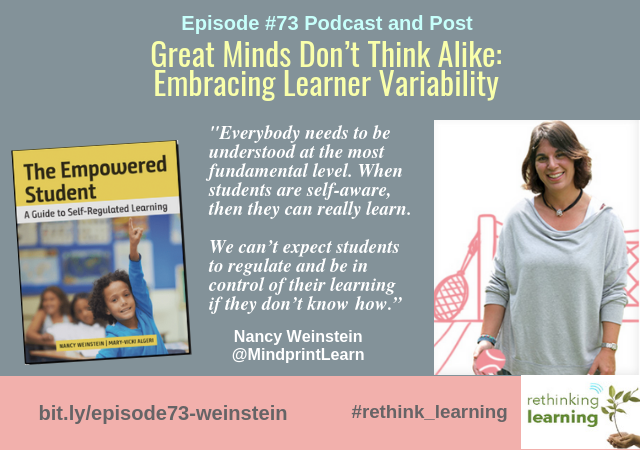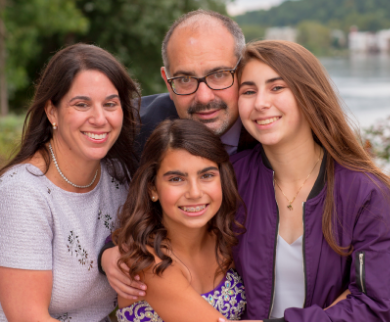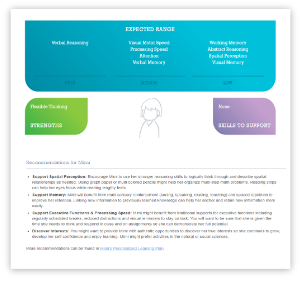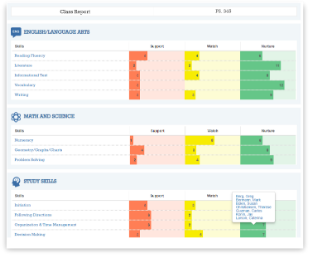Nancy Weinstein, Co-Founder and Chief Executive Officer of Mindprint Learning, has an MBA from Harvard Business School with an extensive background in business, including work at Goldman Sachs, The Walt Disney Company Corporate Strategic Planning, Bristol Myers Squibb, and several smaller Internet companies.

Podcast: Play in new window | Download
Nancy recognizes the challenges students face today, from succeeding at school to managing hectic after-school schedules, to dealing with social media. While we can’t put the genie back in the bottle, she knows that teachers and parents can (must!) help students learn to manage these complex demands. She co-authored a new book, The Empowered Student that we talk about in the podcast. So honored to have a conversation with Nancy. Enjoy!
Your background
I grew up in New Jersey and lived in the same house for 18 years before I went to college in Philadelphia. I started dating my husband in college. We went to the same high school but did not date in high school. He is my co-founder of Mindprint Learning and also the co-founder of my two children. After college, I worked on Wall Street in NY for a couple of years. Then I always wanted to live in California, so I took a job at Disney in their corporate strategic planning group in Burbank, CA. I did that for some time and then because my whole family was back east, I moved back. My family lives in New Jersey outside of Princeton.
What was it like for you as a student?
I was a good student and followed the line. Even though I understood things, I was always stressed. I know now working on Mindprint why. I had a good ability to reason but I didn’t have a very good memory. Studying always took me longer than it felt like it should. I believed that if I didn’t study harder than I would forget on the test. It was so stressful. It didn’t need to be that way.
The reason I became an engineer instead of going to medical school is that I didn’t need to memorize anything. In engineering, every test was open book, open note. It was all about problem-solving. Everything in pre-med was about memorizing (or at least that is how I perceived it). So even though I would have loved medicine, I became an engineer instead because it felt less stressful. In hindsight, if someone had just shown me HOW to study better, I would have done what I really wanted to do — not just what I thought was more achievable.
Retention is all about how we make those connections to things that we know so that we can make what we are learning stick.
Consider students studying history. If we begin by discussing what’s going on today in the world, we make it relevant. We show them why they should care. Then we can compare the similarities or differences to events in history. Students will be more engaged and they will remember more because it’s relevant and it has context.
You and your family
You might say we are all in this together. My experiences with my daughters’ schooling inspired the idea for Mindprint and my husband helped me start the company. He was my #1 supporter getting this company going as a mom with two school-aged kids, and he continues to help me with everything from finance to strategy to legal.

My daughters also play key roles for me. If they weren’t so supportive of my doing this, I really wouldn’t be here. And they also help with the company on a regular basis. A lot of the images you see on our site, my older daughter created. She did almost all the images for our book at age 12. Her strengths are so opposite of mine. She is an amazing designer and I have a terrible time with it. My younger daughter is my “go to person”. If I want to figure out if we should try something new for students, I ask her first. She has this great self-awareness of what will and won’t work for her. She also has great empathy so she senses what will resonate for peers and what won’t. She’s prevented me from making a lot of mistakes.
How did being a parent encourage you to become involved in education?
I came to education technology as a parent. My daughters are two years, two weeks, two days apart. They are also so different. And so different from my husband and I. It was clear to me After a few attempts at helping with homework that they were not going to adapt to who I was. I needed to adapt to them. And if I didn’t understand them there was no way I could help or be the parent I wanted to be.
I was intent on what I could do differently and started to learn about the brain. Back then I would laugh and say that it was genetically impossible that two people who think so similarly could have two kids two years apart who inherently think so differently. Let’s just say, it’s definitely possible. And common, ask your listeners how many of them have had trouble helping their own kids with homework. And they’re teachers!
Co-Founder of Mindprint Learning, LLC
I started reading and learning about educational evaluations that identify how students learn. One of the things I discovered was that these tests were really expensive, time intensive, and only available from a child psychologist. It made me question why in this age of the Internet that this was the only way we could understand how our kids learn. I decided that we could do this testing for each child and it wouldn’t need to be that expensive or time-consuming.
I found this amazing team at the University of Pennsylvania Brain Behavior Lab that developed this short test that could do what we wanted. Fun fact is that NASA uses the same test with the astronauts if you’ve read about the Kelly twins.. https://mindprintlearning.com/blog/nasa-twins-study/
So we are now in schools helping educators understand how each student learns best. If I had known that my reasoning skills are good but my memory is not as good, I could have learned strategies so I could memorize more easily. I probably would have become a doctor. Imagine how less stressful that school would have been for me and how much more I could have enjoyed it. We want to do that for every kid.
Dr. Paul Yellen runs The Yellin Center for Mind, Brain and Education at NYU. He uses the greatest analogy of a tennis player. With enough practice, anyone can be good at tennis. No matter how great a player you are. Everybody has their strong shot and everyone has a weaker shot. You’re constantly strategizing to use your stronger shot and to compensate for your weaker shot. But you know you need to practice both because you’re going to need both shots in a match. his is similar to how we learn. We all have our strongest skills. We all have something we’re not as good at. How do we make sure that we use our strengths to help us succeed without letting our weaker shot get in the way? I love that analogy.
When kids see their learner profile, they feel that finally they are understood. We will hear students say “this is me. Nobody understood me before.” Everybody needs to be understood at the most fundamental level. We use that understanding to create self-awareness. When students are self-aware, then they can really learn. We can’t expect students to regulate and be in control of their learning if they don’t know how–what strengths can they use and where they might need to compensate. Just like tennis players.
Mindprint Profile learning strengths and needs

Action (Personalized Toolbox) that includes Individual Learning Plans and aggregated data for whole class instruction

Nancy shared all of the amazing resources on MindPrint Learning. Make sure you check out this page to find strategies and tools to support every student’s academic, cognitive, and social-emotional strengths and needs.
The Empowered Student: A Guide to Self-Regulated Learning by Nancy Weinstein and Mary-Vicki Algeri (Book) published by CAST
http://castpublishing.org/books-media/empowered-student/
In The Empowered Student: A Guide to Self-Regulated Learning, authors Nancy Weinstein and Mary-Vicki Algeri provide teachers with a practical workbook so they can help students develop the skills they need to take charge of their own learning.
Part 1 is dedicated to getting students on board, laying the foundation for self-regulated learning with the basic neuroscience on how learning happens and what that means in practical terms for effort and motivation.
Part 2 gets specific, delving into exactly what self-regulation looks like in the classroom, relying on the Universal Design for Learning curriculum development framework developed by the researchers at CAST.
This book is packed with tips, strategies and student activities, The Empowered Student is light on words and heavy on examples. The authors assert that self-regulation is not just a set of skills but a way of being, and students who learn it need the guidance of patient, caring adults who embrace the trial and error of ongoing personal growth.
****

Nancy Weinstein is the co-founder and CEO of Princeton, NJ-based Mindprint Learning. She founded Mindprint Learning with the perspectives of both a parent and an innovator. Realizing a need to address a common challenge for parents and educators, she drew upon her background in science and business to create Mindprint.
Nancy has an extensive background in business, including work at Goldman Sachs, The Walt Disney Company Corporate Strategic Planning, Bristol Myers Squibb, and several smaller Internet companies. Nancy has an MBA from Harvard Business School with first-year honors and a BS/BSE summa cum laude from the University of Pennsylvania and Wharton School of Management and Technology Program, Bioengineering and Finance.
Contact Information
- Email: nancy@mindprintlearning.com
- Website: https://mindprintlearning.com
- Twitter: @MindprintLearn
The only universal characteristic of successful students is that they have an adult in their life who is committed to helping them succeed. Each of us has the opportunity to be that adult in a child’s life.
****
Interested in checking out more of the Rethinking Learning podcasts and reflections, click on the podcast tab at the top, the logo below, or go to https://barbarabray.net/podcasts/
For more information about Barbara’s new book, Define Your WHY, go to this page or click on the image of the book for resources, questions, and links.








